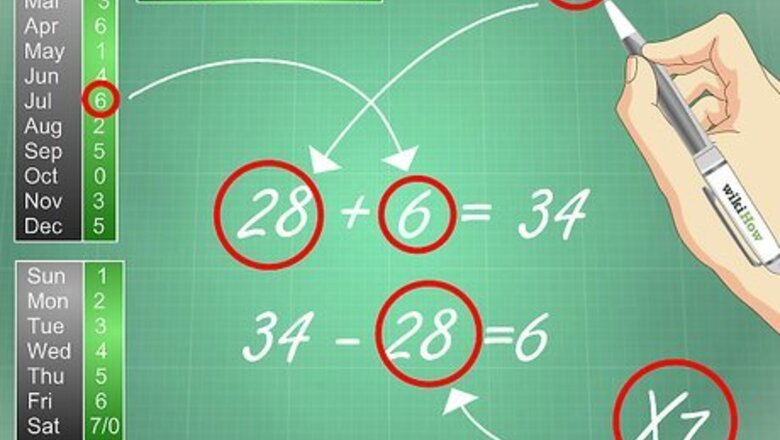
views
Using a Month Table
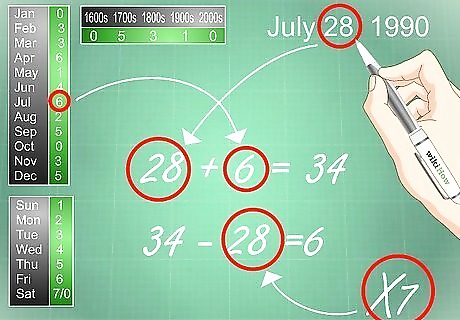
Add the Day and the value for the Month. If the resulting number is greater than 6, subtract the highest multiple of 7 in it. Hold this number.
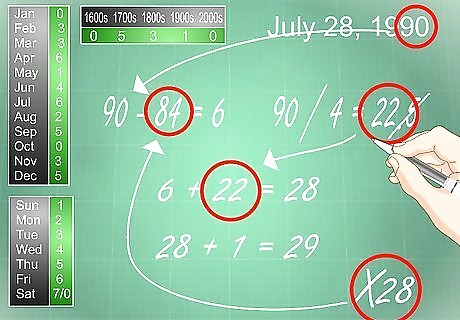
Subtract from the (last two digits of the) Year that has the highest multiple of 28 in it. Add to the resulting number the number you get when you divide it by 4 and round down (i.e., drop the decimal). Now add the value for the Century from the Century Table. If the Month is Jan. or Feb. and the Year is a leap year, subtract 1.
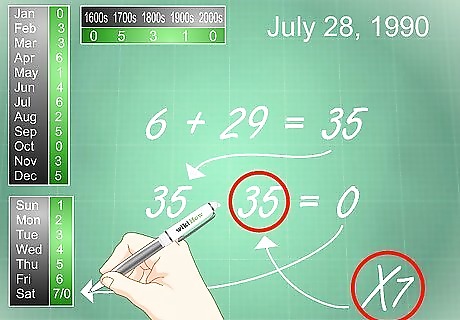
Add the results from the previous steps. If the resulting number is greater than 6, subtract the highest multiple of 7 in it. Using the resulting number, look up the day of the week in the Weekday-Table. Century Table and Year Value. The four-number cycle (0-5-3-1) of the Century Table repeats itself indefinitely, as shown in the table by the 0 for century 2000. So the value for the 3300s would be 5. This value for any century can instead be computed by multiplying 5 times the difference between the (2-digit) century and the highest multiple of 4 in it. For example, the 3400s would be 5 X (34-32) = 10 (and 10, when reduced by the 7s in it, equals 3). This formula could even be extended further to encompass and compute the entire Year value in one felled swoop, but that formula, at its simplest, would be too complicated to carry around in one’s head and then perform the calculation quickly and precisely, which are the goals of the process explained here. Note: This process can be used in reverse to find either the month, day, or year if any one of them is missing but the Day-of-the-Week is known."
Using the 2007 Algorithm

Memorize "2007" and "Wednesday". This is your base day and year. The instructions below will demonstrate how to calculate the day of the week for any day in 2007. The final steps will show how to move this to other years.

Memorize the following dates. In 2007, they are all Wednesdays (your base day for that year) April 4 (4/4), June 6 (6/6), 8/8, 10/10 and 12/12 (December 12). These are easy to remember for Americans or Europeans because of the symmetry. Also, memorize 7/11, 11/7, 9/5 and 5/9 (Memory aid: The people at the 7/11 work from 9 to 5, and reverse the numbers too). You now have 1 day-of-week per month from April through December. January, February, and March have your base day (Wednesday for 2007) on 1/31, 2/7, 2/14, 2/21, 2/28, 3/7, 3/14, 3/21, and 3/28. These should be easy to remember because it is 7,14,21,28, and we're doing math by 7s because there are 7 days per week. You now have 1 day-of-week for every month. From this, you should be able to easily calculate the day-of-week for any date in 2007.
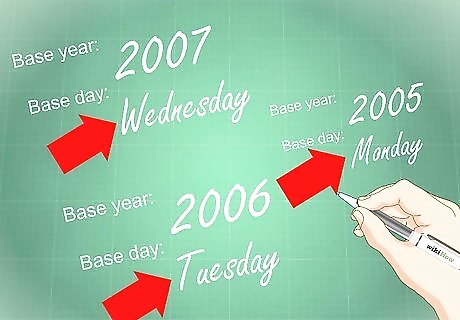
To use this algorithm for other years, increase your day by one for each year (2006 is Tuesday, 2005 is Monday).
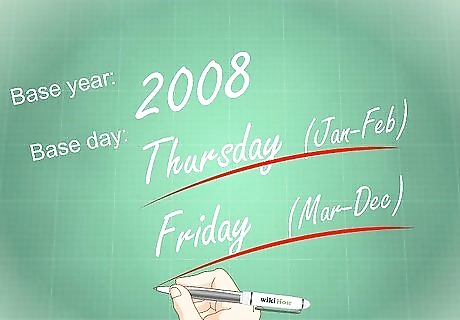
For leap-years, calculate as usual for January and February. Add an extra day for other months, so although 2006 is Tuesday and 2007 is Wednesday, 2008 is Friday (for March and beyond)
Assigning Letters to Days
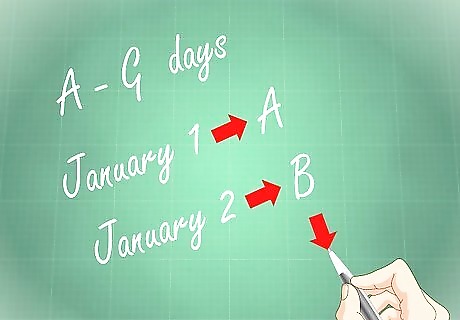
Assign a letter of the alphabet to every day of the year. Since there are seven days in a week, we use seven letters (A through G). January 1 is A, January 2 is B, and so on. After G, it starts over from A again. So since January 7 is G, January 8 will be A again (as will January 15, 22, and 29).
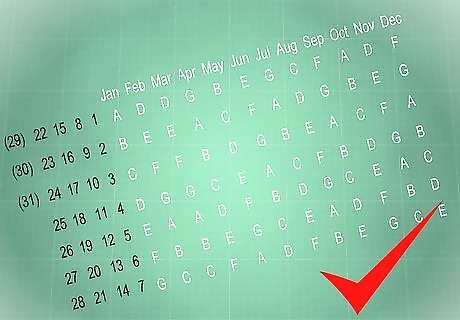
Continue through all 365 days of the year this way. (We are ignoring leap years for now). When we reach December 31, we will be back at the letter A for the fifty-third time. Here is a chart of day letters for the whole year: . ,---,---,---,---,---,---,---,---,---,---,---,---, . |Jan|Feb|Mar|Apr|May|Jun|Jul|Aug|Sep|Oct|Nov|Dec| ,---------------+---+---+---+---+---+---+---+---+---+---+---+---| |(29) 22 15 8 1| A | D | D | G | B | E | G | C | F | A | D | F | |---------------+---+---+---+---+---+---+---+---+---+---+---+---| |(30) 23 16 9 2| B | E | E | A | C | F | A | D | G | B | E | G | |(31) 24 17 10 3| C | F | F | B | D | G | B | E | A | C | F | A | | 25 18 11 4| D | G | G | C | E | A | C | F | B | D | G | B | | 26 19 12 5| E | A | A | D | F | B | D | G | C | E | A | C | | 27 20 13 6| F | B | B | E | G | C | E | A | D | F | B | D | |---------------+---+---+---+---+---+---+---+---+---+---+---+---| | 28 21 14 7| G | C | C | F | A | D | F | B | E | G | C | E | '---------------'---'---'---'---'---'---'---'---'---'---'---'---'

Know which letter is the Sunday Letter (a self-explanatory term) for the year you care about. For 2005, the Sunday Letter is B. For 2006, it is A. (back one letter from the year before) For 2007, it is G. (again, back one letter from the year before -- G is considered to be one letter back from A) 2008 is a leap year. For January and February, the Sunday Letter is F (one letter back from the year before), but the leap day, February 29, causes a disruption. For March through December, the Sunday Letter is E. For 2009, the Sunday Letter is D. (Again, one step back.) Here is the whole table: . ,----,----,----,----, . |1600|1700|1800|1900| . |2000|2100|2200|2300| ,-----------+----+----+----+----| | 00| BA | C | E | G | |-----------+----+----+----+----| |85 57 29 01| G | B | D | F | |86 58 30 02| F | A | C | E | |87 59 31 03| E | G | B | D | |88 60 32 04| DC | FE | AG | CB | |-----------+----+----+----+----| |89 61 33 05| B | D | F | A | |90 62 34 06| A | C | E | G | |91 63 35 07| G | B | D | F | |92 64 36 08| FE | AG | CB | ED | |-----------+----+----+----+----| |93 65 37 09| D | F | A | C | |94 66 38 10| C | E | G | B | |95 67 39 11| B | D | F | A | |96 68 40 12| AG | CB | ED | GF | |-----------+----+----+----+----| |97 69 41 13| F | A | C | E | |98 70 42 14| E | G | B | D | |99 71 43 15| D | F | A | C | | 72 44 16| CB | ED | GF | BA | |-----------+----+----+----+----| | 73 45 17| A | C | E | G | | 74 46 18| G | B | D | F | | 75 47 19| F | A | C | E | | 76 48 20| ED | GF | BA | DC | |-----------+----+----+----+----| | 77 49 21| C | E | G | B | | 78 50 22| B | D | F | A | | 79 51 23| A | C | E | G | | 80 52 24| GF | BA | DC | FE | |-----------+----+----+----+----| | 81 53 25| E | G | B | D | | 82 54 26| D | F | A | C | | 83 55 27| C | E | G | B | | 84 56 28| BA | DC | FE | AG | '-----------+----+----+----+----| . |1600|1700|1800|1900| . |2000|2100|2200|2300| . '----'----'----'----'

Put these together to find the day of the week of any date. For example, let's try June 2007. The year 2007 is G. We see from the day table that June 3 is G and therefore a Sunday. But we wanted to know about June 4. June 4 is the day after June 3. Therefore, June 4, 2007, is a Monday.
Using the Doomsday Algorithm
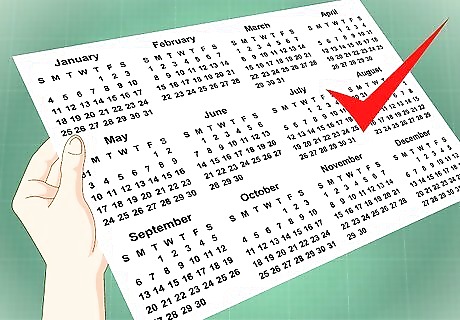
First, you can use the info down below for help.… The Gregorian Calendar [1]

Years Years divisible by 4 are leap years… with the exception that years divisible by 100 are not leap years… with the exception that years divisible by 400 are leap years. Non-leap years will be referred to throughout the guide as “normal years.” The Gregorian calendar repeats exactly every 400 years. Note that the Gregorian calendar has been reformed in the past and that this algorithm only applies to the Gregorian calendar in its most recent state. For more information on this reform and its consequences for calculating the day of the week, refer to the “Julian calendar” section of the Wikipedia article entitled “Doomsday rule”: http://en.wikipedia.org/wiki/Doomsday_rule#Julian_calendar. In this guide, the notation “C.E.” and “B.C.E.” will be used. “C.E.” means “Common Era” and is equivalent to “A.D.” “B.C.E.” means “Before the Common Era” and is equivalent to “B.C.” For more information refer to the Wikipedia article entitled “Common Era”: http://en.wikipedia.org/wiki/Common_Era. Think of C.E. years as positive and B.C.E. years as negative (but subtract one from them first). For example, think of 1670 C.E. as 1670, but think of 1540 B.C.E. as -1539. Note that there is no year 0 in the Gregorian calendar, so you must subtract 1 from 1540 before placing a negative sign in front of it. For a more detailed explanation, see the Wikipedia article entitled “Astronomical year numbering”: http://en.wikipedia.org/wiki/Astronomical_year_numbering. In this guide, the formats mm/dd and mm/dd/yy will be used to represent dates in a compact form. For example, 8/6 is equivalent to August 6th, 7/24/1670 is equivalent to July 24th, 1670 C.E., 12/6/534 is equivalent to December 6th, 534 C.E., and 10/23/-1889 is equivalent to October 23rd, 1890 B.C.E. Note that the algorithm is based heavily on the Doomsday Algorithm, which is easy-to-use (requiring only knowledge of addition, subtraction, multiplication, and division), requires very little memorization, and can be extraordinarily fast with practice. The Doomsday Algorithm was developed for many years by John Horton Conway[2], a renowned mathematics professor at Princeton University, who took up day-of-the-week calculation as a hobby. At the time that he taught me the algorithm, he could calculate the day of the week in his head for ANY date on the Gregorian calendar in 3 seconds flat. Watch this performance by Arthur “Art” T. Benjamin[3], the “Mathemagician” and a math professor at Harvey Mudd College, if you doubt that the algorithm can be performed this quickly: http://www.ted.com/index.php/talks/arthur_benjamin_does_mathemagic.html. The day-of-the-week calculation is one of his later “MathMagic” tricks. While some have never met anyone who is that fast after first learning the algorithm, you can drastically improve your speed with practice. The Doomsday Algorithm relies on a branch of mathematics known as modular arithmetic [4]. The algorithm only works for the Gregorian Calendar, but similar tricks could be developed for any calendar system. This guide does not assume a mathematical background; for those with more mathematical sophistication the Wikipedia article entitled “Doomsday rule”[5] and the Advanced Tricks for Greater Speed section of this guide would be more appropriate. There are lots of examples throughout the guide intended to clarify various aspects of the algorithm; feel free to skip them if you already understand the concepts they illustrate. All of the days of the week mentioned in the examples are correct, but you shouldn't worry if you don’t know how they were calculated while reading the guide for the first time. There is also some deliberate repetition to hammer in some of the subtler concepts that you may wish to skim over if you already understand them.
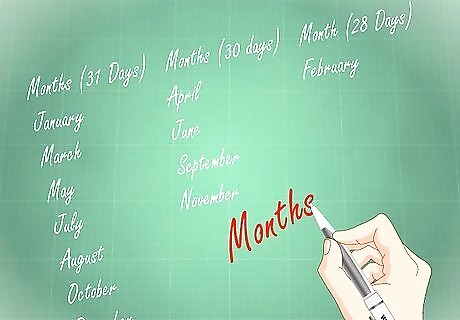
Months January, March, May, July, August, October, and December have 31 days. April, June, September, and November have 30 days. February has 28 days during a normal year and 29 days during a leap year. Leap day, that is, the day that only exists during a leap year is February 29. There is a useful mnemonic to distinguish between months with 31 days and fewer than 31 days. Hold out your right hand. Tap the knuckle of your index finger and say “January.” Tap the gap/dip/valley between the knuckles of your index and middle fingers and say “February.” You can remember that January has more days than February because your knuckle is taller than the gap. Next, tap the knuckle of your middle finger and say “March.” Notice as you continue that all of the months with 31 days are on knuckles, while all of the months with fewer days are in gaps. You’re probably wondering: “What do I do once I get to July?” because July is on the knuckle of your pinky. Just go back to the beginning; tap the knuckle of your index finger again and say “August.” Continue from here to get to the rest of the months.

Days In any given year (even a leap year), “Doomsdays” are all on the same day of the week. Here are some easy-to-remember Doomsdays: 4/4, 8/8, 10/10, 12/12, 5/9, 9/5, 7/11, and 11/7. A mnemonic for the last four Doomsdays in the list is: “9 to 5 job at a 7-11 gas station.” For example, in the year 2000, April 4, June 6, July 11, and November 7 are all Tuesdays. (Important note: this does not mean that April 4, 2001, was also Tuesday. April 4, 2001, was a Wednesday.) You can add or subtract 7 from any Doomsday to get another Doomsday. For example, 5/9, 5/16, and 5/23 are all Doomsdays. You don’t have to just add or subtract 7 at a time though; you can use any multiple of 7. For example, 9/5 and 9/26 are both Doomsdays, because of 5+7*3 ≡ 26. Another easy-to-remember Doomsday is 3/0. No this is not a typo; 3/0 is simply another way of thinking about the last day of February. Unlike 2/28 or 2/29, 3/0 is always the last day of February, regardless of whether or not it is a leap year. The world can even think of months as having negative days. For example, 8/8 and 8/-6 are both Doomsdays. To convert 8/-6 into a normal date, simply add the number of days in the 7th month (July). Use the knuckle trick from the previous paragraph to determine that there are 31 days in July. So, 8/-6 is the same as 7/25, because -6+31 ≡ 25. We may also think of months as having days greater than 31. For example, 10/10 and 10/34 are both Doomsdays. To convert 10/34 into a normal date, simply subtract the number of days in the 10th month (October). Our knuckles tell us that October has 31 days, so 10/34 is 11/3 because 34-31 ≡ 3. We can even write June days as March days. For example, 6/6 and 6/-64 are Doomsdays. May (month 5) has 31 days, so 6/-64 ≡ 5/-33. April (month 4) has 30 days, so 5/-33 ≡ 4/-3. March (month 3) has 31 days, so 4/-3 ≡ 3/28. Thus, June -64th is equivalent to March 28th, which is a Doomsday. Be careful to account for leap years when using these tricks to determine Doomsdays in January or February. For example, in ANY year, 3/0 and 3/-14 are both Doomsdays, but in a leap year February has 29 days, so 3/-14 ≡ 2/15, while in a normal year February has 28 days, so 3/-14 ≡ 2/14. Thus, February 15th is a Doomsday during leap years, but February 14th is a Doomsday during normal years. You have to be careful when going from March to January as well. Leap year: 3/-42 ≡ 2/-13 ≡ 1/18; normal year: 3/-42 ≡ 2/-14 ≡ 1/17.

Now that you know how the Gregorian calendar works, you can use your knowledge to… Calculate the Day of the Week in Your Head From the Year, Month, and Day Number-days “Number-days” are numbers that are associated with days of the week by a mnemonic. Sunday ≡ NONEday ≡ 0 Monday ≡ ONEday ≡ 1 Tuesday ≡ TWO’Sday ≡ 2 Wednesday ≡ THREE’Sday ≡ 3 (lame, I know) Thursday ≡ FOUR’Sday ≡ 4 Friday ≡ FIVEday ≡ 5 Saturday ≡ SIXAday ≡ 6 Sunday ≡ SE’ENday ≡ 7 (“sen” as in a contraction for “seven” that sounds like “sun”) Because there are seven days in a week, you can add or subtract any multiple of 7 at ANY point during ANY part of ANY day-of-the-week calculation. This is why Sunday is both 0 and 7. Monday could be thought of as -6, 8, 71, etc. Throughout the guide you will see (and have been seeing) congruence symbols, ≡, rather than equals signs, =, because 71 does NOT equal 8, but they are equivalent to determine the day of the week. While finding a day of the week we are only interested in the remainder when numbers are divided by 7. All of these congruences are thus “modulo 7,” abbreviated “mod 7.” Numbers are congruent modulo 7 if their remainders are the same when they are divided by 7. This is equivalent to the earlier point that you can add or subtract multiples of 7 as you wish. For example, 1 ≠ 8, but 1 ≡ 8 (mod 7). More examples of how modulo behave are -15 ≡ -1 ≡ 6 (mod 7) and 4 ≡ -3 ≡ 7004 (mod 7). The notation “(mod 7)” will be left off throughout the guide, because all congruences are assumed to be modulo 7. If you know that August 8, 1953, is a Saturday, then you can quickly determine that August 4, 1953, is a Tuesday, because four days before SIXAday is TWO’Sday. That is, 6-4 ≡ 2. Likewise, if you know that 9/5/1776 is a FOUR’Sday, then you can quickly see that 9/7/1776 is a SIXAday, because of 7-5 ≡ 2 and 4+2 ≡ 6. Remember that you can add or subtract any multiple of 7 to a Number-day. If you know that 10/10/-2543 is a SIXAday, then you can quickly determine that 10/2/-2543 is a FIVEday, because of 2-10 ≡ -8 ≡ -8+7 ≡ -1, and 6+(-1) ≡ 5. Once again, remember to watch out for leap years, like 18,400. If you know that 2/28/18,400 is a ONEday, then you can quickly determine that 3/3/18,400 is a FIVEday, because of 2/28/18,400 ≡ 3/-1/18,400 and 3-(-1) ≡ 4 and 1+4 ≡ 5.
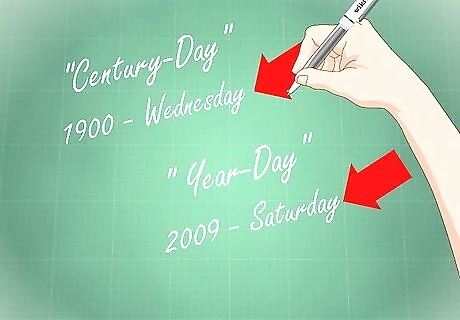
Definitions of Year-days and Century-days The “Year-day” of any given year is the day of the week on which all of its Doomsdays lie. For example, every Doomsday in 2009 is a Saturday, so the Year-day of 2009 is Saturday. The “Century-day” of any given century is the “Year-day” of the first year of the century. The “Century-year” is the first year of any given century. The Year-day of 1900 is Wednesday, so the Century-day of the 1900s (i.e. the 20th century) is Wednesday. Also, 1900 is the Century-year of the 20th century. Note though, that the Century-year of the century that -1362 lies in (i.e. the -1300s or the 14th century B.C.E.) are -1400, NOT -1300 because -1400 comes before -1300. Remember also that -1400 is equivalent to 1401 B.C.E., NOT 1400 B.C.E.
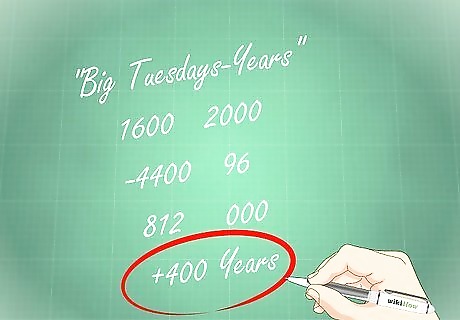
Calculating Big Tuesdays (400 Years) The Year-day of every year divisible by 400 is Tuesday. These Year-days are called “Big Tuesdays” (just to help you remember them). Years that are divisible by 400 are called “Big Tuesday-years,” and centuries that have Century-days that are also Big Tuesdays are called “Big Tuesday-centuries.” Thus, the Year-day of 1600 is a Big Tuesday. The Century-days of the 2000s, the -4400s, and the 96,812,000s are all Big Tuesdays, the 2000s, the -4400s, and 96,812,000s are all Big Tuesday-centuries, and 2000, -4400, and 96,812,000 are all Big Tuesday-years.
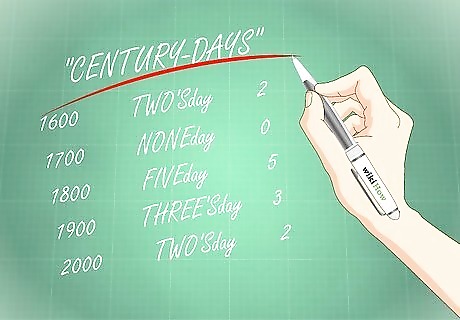
Calculating Century-days (100 Years) If you are not in a Big Tuesday-century, then you can find the Century-day as follows. Subtract 100 from the Century-year until you get to a Big Tuesday-year. Count how many times you subtracted 100. If you subtracted 100 once, then the Century-day is Sunday; if twice, then it’s Friday; if thrice, then it’s Wednesday; if four or more times, then you messed up because one of every four Century-years is a Big Tuesday-year. For example, the Century-day of the 1800s is Friday, because you subtract 100 twice to get 1600, which is a Big Tuesday-year (because it’s divisible by 400). The pattern looks like this: 1600 ≡ TWO’Sday ≡ 2, 1700 ≡ Sunday ≡ 0, 1800 ≡ FIVEday ≡ 5 ≡ -2, 1900 ≡ THREE’Sday ≡ 3 ≡ -4, 2000 ≡ TWO’Sday ≡ 2 ≡ -5, and so on. Note that you can get from one Century-day day to the next by subtracting two from the initial Century-day. This only works when the larger of the two adjacent centuries is not a Big Tuesday-century. That’s fine though because you already know that the Century-day of every Big Tuesday-century is TWO’Sday.
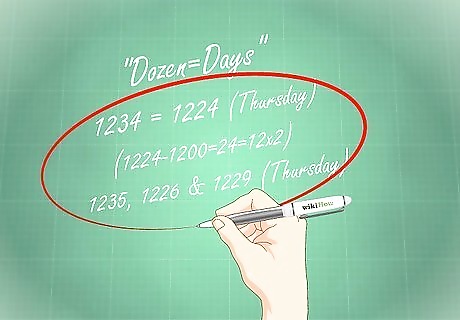
Calculating Dozen-days (12 Years) The “Dozen-year” of any given year is the largest year that is both less than or equal to the given year and that has the property that the positive difference of itself and the Century-year is divisible by 12. The “Dozen-day” of any given year is the Year-day of the Dozen-year. The Dozen-day can be calculated by adding the Century-day to the result of the division by 12. For example, the Dozen-year of 1234 is 1224, because of 1224-1200 ≡ 24 ≡ 12*2, and no larger years that are still less than or equal to 1234 yield a positive difference with 1200 that is divisible by 12. Since the Year-day of 1224 is Thursday, the Dozen-day of 1234 is also Thursday. Note that the Dozen-days for 1235, 1226, and 1229 are all Thursdays as well; while the Dozen-days for 1236 and 1238 are not the same (they are, in fact, Fridays). For another example, we can calculate the Dozen-day of -1713. We first need to find the Century-day of the -1700s. Since we must subtract 100 three times from -1700 to arrive at a Big Tuesday-year, the Century-day is THREE’Sday. Next, we must find Dozen-year. Note that the Dozen-year is not -1712, but rather -1716, because -1716-(-1800) = 84 = 12*7. So, the Dozen-day of -1713 is 3+7 ≡ 3 ≡ THREE’Sday (since we can subtract 7 as we please).
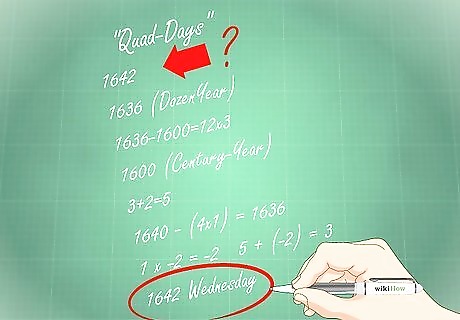
Calculating Quad-days (4 Years) The “Quad-year” of any given year is the greatest number that is both less than or equal to the given year and divisible by 4. The “Quad-day” of any given year is the Year-day of the Quad-year. For example, the Quad-year of 1620 is 1620; while that of 1643 is 1640. The Quad-days of 1640, 1641, 1642, and 1643 are all Wednesday; while the Quad-day of 1620 is Saturday. We can calculate the Quad-day as follows. If the given year is 1642, then the Dozen-year is 1636, because of 1636-1600 ≡ 12*3. The Century-year, 1600, is a Big TWO’Sday. 3+2 ≡ 5, so the Dozen-day of 1642 is Friday. Subtract 4 from the Quad-year, 1640, until you get to the Dozen-year. Multiply the number of times you subtracted 4 by -2, and add this result to the Dozen-day to get the Quad-day. In our example, 1640-4*1 ≡ 1636, 1*-2 ≡ -2, and 5+(-2) ≡ 3, so the Quad-day of 1642 is Wednesday (as mentioned previously). Wednesday is thus also the Year-day of 1640.
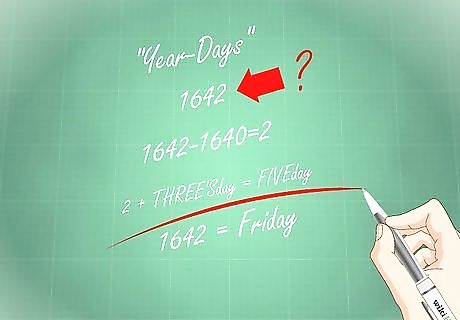
Calculating Year-days (1 Year) If the given year is not divisible by 4, like 1642, then subtract the Quad-year from the given year. Add the result to the Quad-day to get the Year-day. In our example, 1642-1640 ≡ 2, and 2+THREE’Sday ≡ FIVEday, so the Year-day of 1642 is Friday.
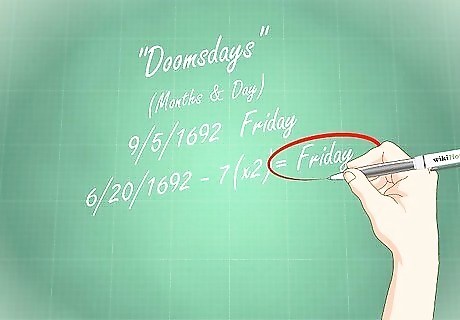
Calculating Doomsdays (Months and Days) Once you know the Year-day, you know the day of the week of every Doomsday in that year. For example, if the date were 9/5/1642, you would already know that it was a Friday. If the date were 6/20/1642, then you would subtract 7 days twice to discover that 6/20/1642 is the same day of the week as 6/6/1642, which is a known Doomsday. This means that 6/20/1642 is also a Doomsday, and is, therefore, a Friday.
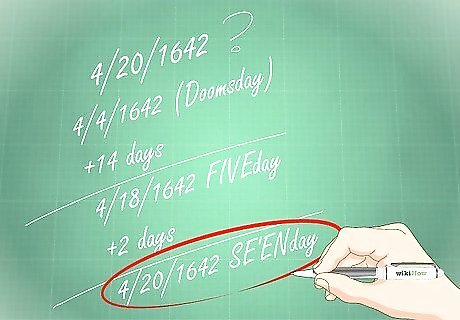
Calculating Days of the Week (Days) If you’re given a date like 4/20/1642, which is not a Doomsday, then simply find the nearest Doomsday by repeatedly adding or subtracting 7 to known Doomsdays. We know 4/4/1642 is a Doomsday, so we add 14 days to discover that 4/18/1642 is a Doomsday. Now we know that 4/18/1642 is a FIVEday, so we simply add 2 days to find that 4/20/1642 is a SE’ENday. Don’t forget that the nearest known Doomsday may not be in the same month. For example, 3/29/1642 is closer to 4/4/1642 than to 3/0/1642. Since 4/4/1642 ≡ 4/-3/1642 ≡ 3/28/1642, we know that 3/29/1642 ≡ FIVEday + 1 ≡ SIXAday.
Assigning Numbers to Days and Months

Use this table to know the values of the days: 0 Saturday 1 Sunday 2 Monday 3 Tuesday 4 Wednesday 5 Thursday 6 Friday (7 Saturday)
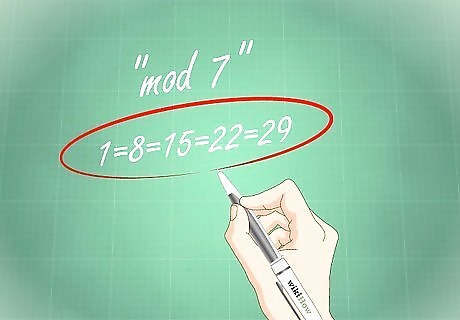
Remember that in mod 7 the numbers 1, 8, 15, 22, and 29 are equal

Use this table to know the values of the months. Jan Feb Mar 0 3 3 Apr May Jun 6 1 4 Jul Aug Sep 6 2 5 Oct Nov Dec 0 3 5

Use this table to know the values of the years (come back to this later if it does not make sense now) 0-2345- 0 0123-56 5 01-3456 11 -1234-6 17 012-456 22



















Comments
0 comment